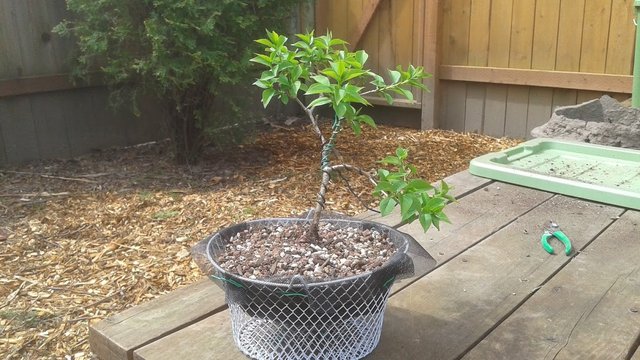
This post is a follow-up on my DIY Project: Let's Make Bonsai Training Pot. That post has become very popular in the last few days. It talks about why a training pot is needed, how it helps root growth and trunk thickness, how I made the training pots, and why I designed the training pots the way I did.
In this post, I'll be showing the results of what it looks like transplanting a young tree into one of these self-made wire basket pots.
Every photo in this post is original works.
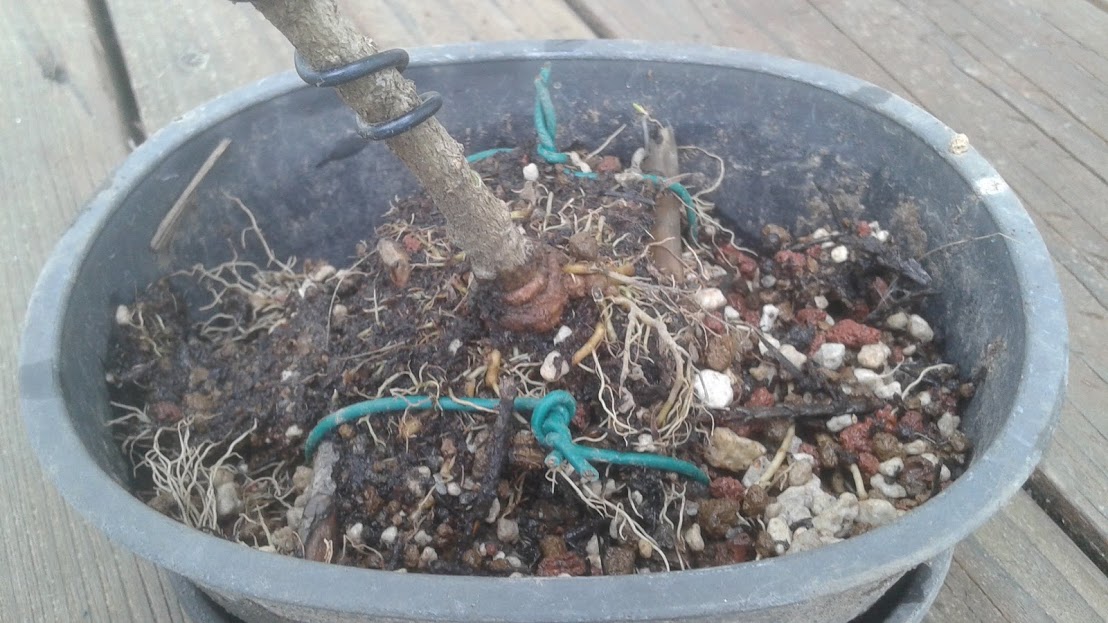
As you can see in the two photos above, the tree really needed some help. Even though this Forsythia tree is a vigorous grower, it has not developed a good spread of roots. The pot had been spilled several times due to squirrels and humans, leaving the roots exposed to the air.
In the new wire pot, I used a bonsai mix as the primary soil, which consists of inorganic lava rock, pumice, akadama clay, and granite. I also mixed in a cheaper bonsai potting soil mix, which includes some pine wood bark, in smaller pieces.
.jpg)
For my next transplant, I have this lime tree I wanted to move into a new training pot. It has been growing in this blue pot for about two or three years, and it has a sister tree growing up alongside it. The tree has been very loose in this mix of potting soil, and I would like to have it fixed more firmly in the pot so it can develop stronger.
The first thing I do is remove it from the pot, to find out what the root structure looks like.
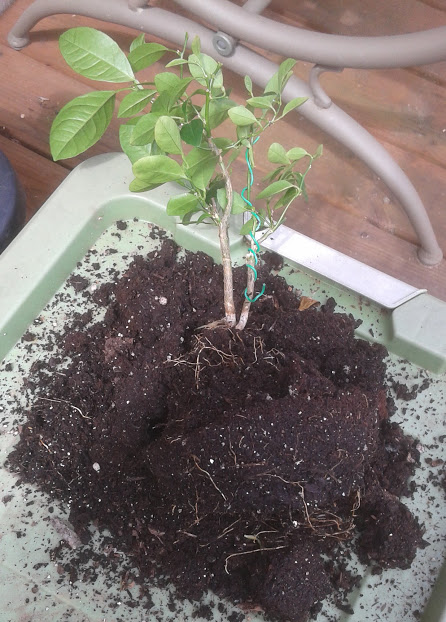
The trees are grower very close together at the base.
Most of the soil was falling off the roots with even gentle handling.
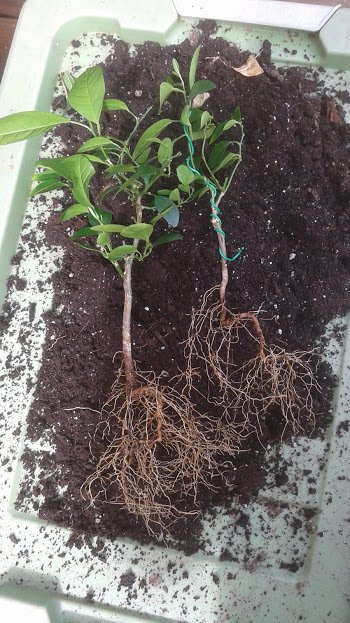
This is the strangest root shape I have ever found in my trees.
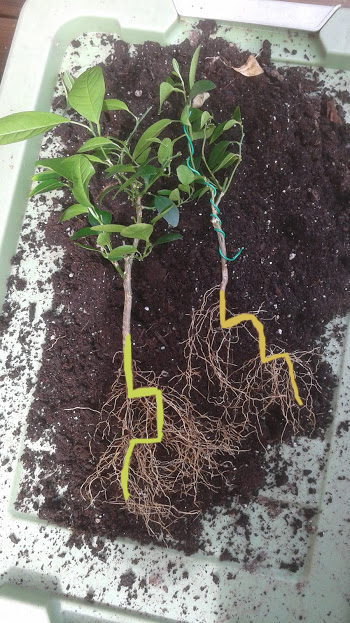
Both trees formed a square-shaped root around a corner, and continue to zig-zag. All the other roots are growing freely in long strands, like hair.
There is no thickening in the trunk above the root zone.
At this point I ran into quite a few difficulties. I decided to switch to the same inorganic soil as I used for the Forsythia tree, but my supply for bonsai soils is getting very low.
Positioning the trees in the new pot was also very difficult due to the odd shape of the roots.
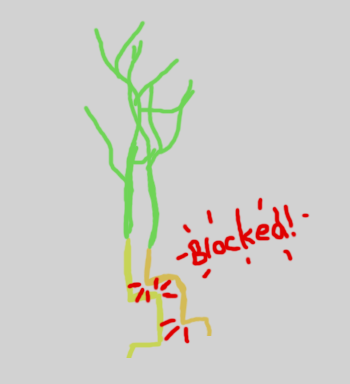
At first I tried positioning them side-by-side, as they were before, but they were not able to stay upright or remain close together. The roots were blocking the roots of the other tree.
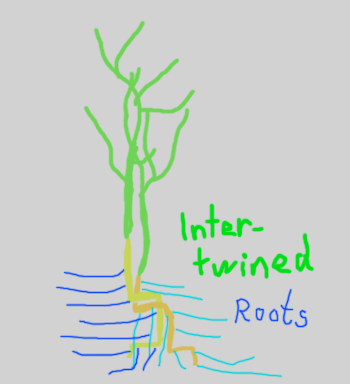
It then struck me that these trees are better suited to be slightly inter-twined in the roots if I want to keep them close together. Let them support eachother, instead of resist eachother. I was able to use the shape of the taproot on the dominant tree to encase around the taproot of the smaller tree. For all the fine roots, I spread them outward, with most the roots of one tree headed to one side of the pot, and the roots of the other tree headed to the other half of the pot. I also like to use a few wooden sticks to tie my wires to, to hold the roots down snugly.
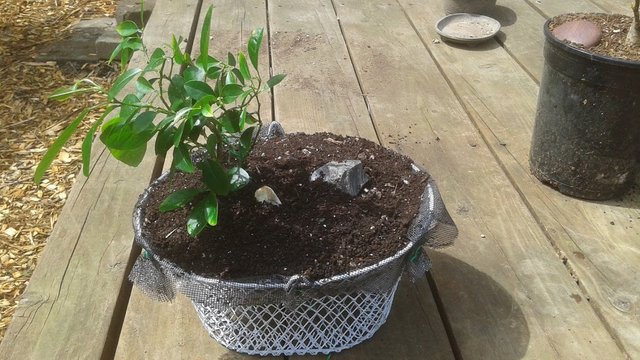
Here is what it looks like after I finished. I decided to keep some of the old potting soil and use that as a thin top mulch layer. I really do not want this lime tree to dry out in the new rocky soil, and I think the potting soil will also help keep some of the moisture and nutrients close to the roots. A few decorative rocks were added, buried under the surface.
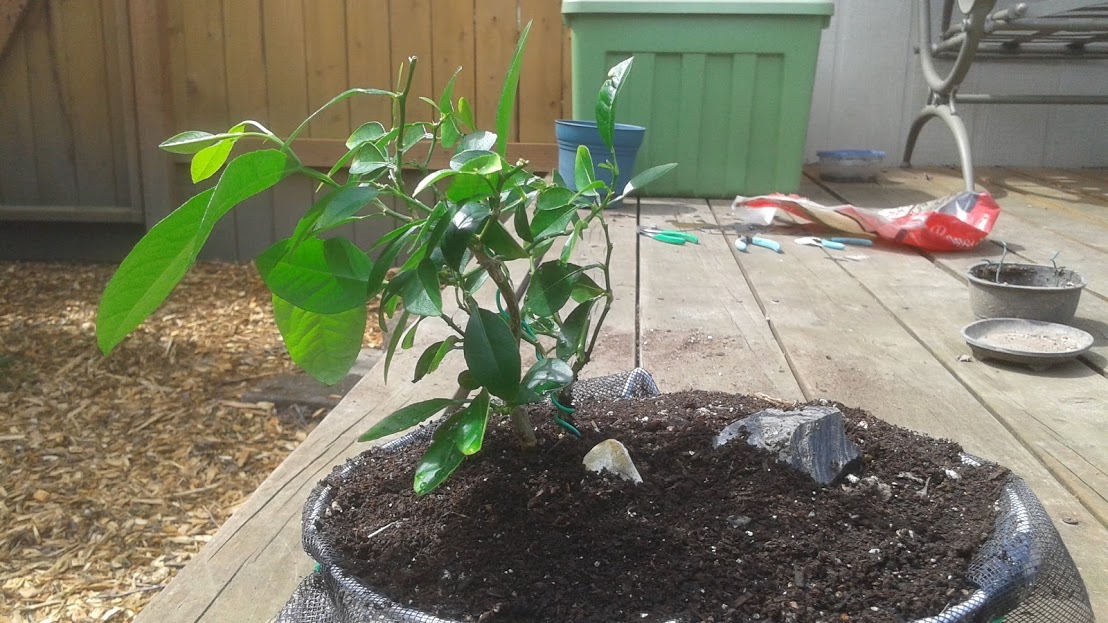
The angles of the two trees are slightly different than before, but I did my best to use the soil to prop it up at a suitable angle. Next time I do this, I might try using some kind of a clamp to maintain the two trunk angles while I work with the soil, roots, and wiring of the roots to position the tree.
This is the first time I have brought this tree outdoors for the year, so I'll be keeping it in the shade for a few weeks until it shows signs of strong new growth.
Thanks for viewing my post. I enjoy sharing my journey with others. Mistakes, successes, mishaps, discoveries, and all.

Try something new for a change. Variety is the spice of life.

very looking tree photography post..
Downvoting a post can decrease pending rewards and make it less visible. Common reasons:
Submit
very useful information @ creativetruth.hari I will practice this way of plant cuttings as you described in the previous post.terimili kawan.informasi very valuable to me
Downvoting a post can decrease pending rewards and make it less visible. Common reasons:
Submit
wow that the problem of the roots, I thought that it was two trunks that shared the same root system. Friend you can apply to the foliage water with sprinkled sugar, this helps to recover the plants from the stress caused by transplants with exposed roots.
Downvoting a post can decrease pending rewards and make it less visible. Common reasons:
Submit
Thanks for the tip. What would be a good amount to use? Can I just sprinkle a teaspoon or so on the surface, and water it in?
Downvoting a post can decrease pending rewards and make it less visible. Common reasons:
Submit
Hey there! I think what he means is only foliar (branches and leaves) so make sure that you don't get much of that water into the soil. Not sprinkle it but use a spray bottle instead would be my suggestion. I try to use liquid vermicompost for the best results, any foliar product will do for this early stage. I bought a really nice one for orchid development, but it serves for frugal and edible plants as well. And the cheaper product I use is distilled water from the AC, but I guess you don't really use these kind of devices over there, or do you?
Downvoting a post can decrease pending rewards and make it less visible. Common reasons:
Submit
Never thought about using the AC water before. We use a tube to dump the water down the gutter drain.
Downvoting a post can decrease pending rewards and make it less visible. Common reasons:
Submit
Cheers, I'm really digging this way of learning with your advice and well put step by step instructions. Thank you! I wish I could have posted what I did with my lime so you would have an extra starting point for your adventure.
Did you fear to lose one of the plants if you put them into separate pots, or did you just decided to blend them together as before without giving it much thought?
I would encourage to separate the smaller one on a later stage of their development, since you can clearly see that its growth has been really poor when compared to the other taking advantage of the nutrients served on the soil. Remember that nature isn't always nice in these sort of evolutive scenarios. The thing I can say to not make you doubt it too much is that citrus have the ability to "survive" growing close together. But that works better when they're young. You can start dozens of seeds into one tiny cup, but when the roots start to get wider the best thing to do is to separate them and put only one into each pot/space. The main reason for that is that as you could see, a citrus root system is really wide and needs the most space to grow freely those many thinner roots.
My only doubt would be if when you fix the roots with wires, did you put wood on the bottom? I think I really need your help to explain this maybe in a post, where I can tell what I did with my lime tree, and the other ones I have. Don't know if you remember, these roots/trunk are very stiff or hard to shape, and they tend to keep a hard overall structure, so in order to have a better and healthier root system you need to elevate as much as you can the level or height in the pot where you set the root system lower part. I always try to even let the higher roots above the soil for a couple of days/weeks, to see if that nebari does strenghten in a better, healthier and faster way. If you put the roots too down into the pot maybe they won't rot (if you have a good draining system), but it's harder for the plant to develop more roots if it's already at the bottom of the pot. And you have to be very careful with the watering, because if you have wood inside the pot, you could get some rotten roots. Maybe to water them once a day, but only use an ammount of water that is lower than the ammount of soil, that means if you have 5 cups of soil in the pot, use no more than two for the humidity of the soil. But the best way to know for sure is to check how the soil itself is doing with which ammount of water you're giving it.
Prepare to see how those roots are going to reach in no time outside that net lol, with your current weather I think you will watch a lot of growth in no time Such a cool move that you went for!
Downvoting a post can decrease pending rewards and make it less visible. Common reasons:
Submit
Thanks for sharing your experience. The wood I added mainly for support in a lateral direction, so the wires would not crush the oddly shaped roots into a flat shape that might snap them.
I'm going rogue by growing them so close together. We'll see what happens once the roots start developing, and I race to keep the tree pruned down small. Definitely not the natural way the tree would like to grow. 'Tis the bonsai way.
Downvoting a post can decrease pending rewards and make it less visible. Common reasons:
Submit
I think you'll have a blast with your citrus! Maybe it depends a lot of your climate conditions too, but those grow pretty quick and I believe that they do that also based on those same conditions plus the ones you provide. I'm always following your track so I can pick up what you show and what you notice when doing these kind of works. As always, it's a great help for me to see what you think and how you put things clear enough for our learning and better understanding, it's almost as we're right there taking a class! Have a great weekend @creativetruth
Downvoting a post can decrease pending rewards and make it less visible. Common reasons:
Submit